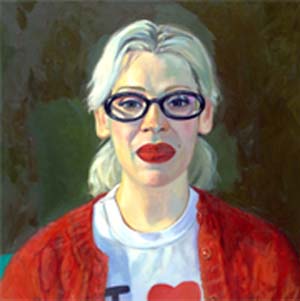Tim Doud
dal 21/3/2002 al 29/4/2002
Segnalato da
21/3/2002
Tim Doud
Priska C. Juschka Fine Art - Old location, New York
"I started painting directly from life to improve my drawing skills - at the time I was painting non-observational paintings with figures in them. I started drawing my friends and the portraits held my interest more than the paintings that I had been creating. I went from making paintings that illustrated what I was thinking about to making paintings that had an inherent content." Tim Doud

INTERVIEW WITH TIM DOUD
Question: Tim, you are a figurative painter. How did you choose your subject matter?
Answer: I started painting directly from life to improve my drawing skills - at the time I was painting non-observational paintings with
figures in them. I started drawing my friends and the portraits held my interest more than the paintings that I had been
creating. I went from making paintings that illustrated what I was thinking about to making paintings that had an inherent
content.
Q: How do you choose your models and what is your relationship to them?
A: I paint my friends, who are the people around me, and I paint them over a long period of time - one of my sitters has been
sitting for me for 10 years. Over the last five years I have gotten to know many performers: dancers, actors, performance
artists, and a lot of them are sitting for me now.
Q: What's your process? How do you choose a pose? How do you develop a painting?
A: I work with the models to develop the poses using multiple drawings. A lot of the decisions have something to do with
what the models do or how they present themselves. I have been paintings one model's birthday outfits and another series of
wedding dresses. One series of drawings, made with four men, are all made
from contrived poses that each model chose. The paintings come from the drawings that resonate with me the most. Some of
the drawings that I choose are just curious to me--others challenge me and I keep coming back to them. If a drawing is too
resolved I don't want to make a painting from it.
Q: I worked as a model for some time in the past: how would you describe the chemistry between the artist and the model?
And the viewer? (What does painting "from the model" make so personal?)
A: The chemistry is great--but different with each person. We all have different relationships with the people around us. I love
to hear what viewers have to say about sitters in the paintings, but I'm not really thinking about the viewer so much while I'm
painting. I spend three hours a week with each person I paint, so it can get very personal (especially in New York where
people don't sit down regularly and talk for three hours straight).
Q: Now, there are other figurative painters- I want to call them traditional-who have very little in common with you. Can you
explain your relationship to them and why you don't consider your work just a continuation of traditional figure painting?
A: It depends on which tradition you are talking about - my work isn't very academic. I'm not primarily concerned with
anatomy. I am interested in the exterior of what I am looking at - kind of like Ingres. There is a tradition of painting in the
studio from life. Maybe it''s my models that aren't very traditional.
Q: If you would have to do something else: What would you do?
A: Well, I like to read biographies so I guess writing would be an option. The problem is that I'm not a very good writer. So, I would like to be a tennis pro. I love tennis.
Image: Tim Doud "Angie (Ruby Woo)" Oil on canvas
Opening March 22, 2002
Priska C. Juschka Fine Art
212 Berry Street (North 3rd and Metropolitan), Brooklyn, NY 11211
Gallery hours: Thursday - Monday 12 - 6pm or By Appointment



